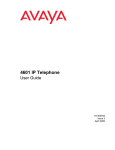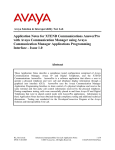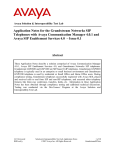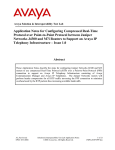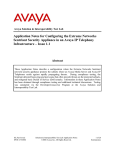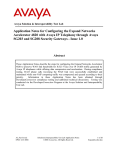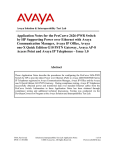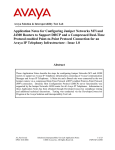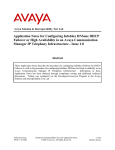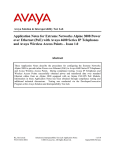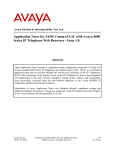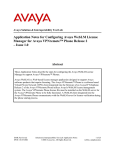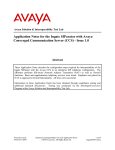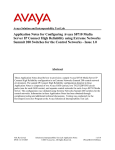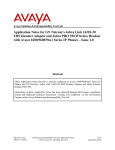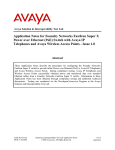Download Avaya 4600 Series IP Telephones Application Note
Transcript
Avaya Solution & Interoperability Test Lab Application Notes for Mirage Networks CounterPoint in an Avaya IP Telephony Infrastructure – Issue 1.0 Abstract These Application Notes describe a configuration where the Mirage Networks CounterPoint network access control appliance protects the subnets where an Avaya Media Server, an Avaya Media Gateway, and Avaya IP Telephones reside against rapidly propagating threats. During compliance testing, the CounterPoint detected basic ping and port scans that often precede threats on the protected subnets, and mitigated basic Denial of Service (DoS) attacks. Information in these Application Notes has been obtained through compliance testing and additional technical discussions. Testing was conducted via the DeveloperConnection Program at the Avaya Solution and Interoperability Test Lab. RL; Reviewed: SPOC 9/23/2005 Solution & Interoperability Test Lab Application Notes ©2005 Avaya Inc. All Rights Reserved. 1 of 17 MirageCP.doc 1. Introduction These Application Notes describe a configuration where the Mirage Networks CounterPoint appliance is deployed in an Avaya IP telephony infrastructure. CounterPoint is a network access control appliance that is designed to protect the internal corporate network against rapidly propagating threats that originate inside the network. CounterPoint operates within the network interior, and is complementary to perimeter security solutions. CounterPoint uses pre-defined and configurable rules in monitoring the network for potential threats. Once a threat is identified, CounterPoint mitigates the threat by “cloaking”, where CounterPoint logically inserts itself in the path between the attacker and the target. Specifically, CounterPoint redirects the attacker communications streams to itself by changing the ARP tables in the attacker and/or target device. CounterPoint can then selectively filter out malicious packets and forward the rest to the target. CounterPoint can also be configured to send alerts via e-mail (SMTP), SNMP, and Syslog when threats are identified. Figure 1 illustrates a sample configuration consisting of an Avaya S8710 Media Server, an Avaya G650 Media Gateway, Avaya IP Telephones, an Avaya P333T-PWR Power over Ethernet Stackable Switch, a Cisco Catalyst 3560 Series switch, an “Attacker” PC, and a Mirage Networks CounterPoint C-245. Avaya Communication Manager runs on the S8710 Media Server, though the solution described herein is also extensible to other Avaya Media Servers and Media Gateways. The S8710 Media Server and G650 Media Gateway reside on VLAN 100 and are connected to the P333T-PWR, which in turn connects to the Catalyst 3560 via an 802.1q trunk. The IP Telephones reside on VLAN 53 and the “Attacker” PC resides on VLAN 51. The CounterPoint C-245 connects to two ports on the Catalyst 3560. The VLANs to be protected (VLANs 53 and 100) are also assigned to the two ports. VLAN 51 could not be protected for reasons discussed in Section 3. The protected VLANs are mirrored to one of the two Catalyst 3560 ports (the “Reader” port”), allowing the CounterPoint C-245 to monitor unicast and broadcast traffic on the protected VLANs. The other port (the “Writer” port) allows the CounterPoint C-245 to transmit ARP messages onto the protected VLANs and perform cloaking. RL; Reviewed: SPOC 9/23/2005 Solution & Interoperability Test Lab Application Notes ©2005 Avaya Inc. All Rights Reserved. 2 of 17 MirageCP.doc COM PACT COM PACT Avaya S8710 Media Server Avaya G650 Media Gateway VLAN 100: 192.45.100.0/24 Avaya P333T-PWR Power over Ethernet Stackable Switch Port 1/24 VLAN 100 802.1q Trunk VLAN Mirror Port 0/22 (VLANs 53, 100) Port 0/23 Catalyst 3560 1 VLAN 51: 192.45.51.0/24 2 3 4 5 6 7 8 9 10 11 12 13 14 15 16 17 18 19 20 21 22 23 SERIES PoE-24 24 1X 11X 13X 23X 2X 12X 14X 24X SYST RPS STAT DUPLX SPEED POE 1 2 MODE Cisco Catalyst 3560 Switch VLAN Trunk Port 0/21 (VLANs 53, 100) VLAN 53: 192.45.53.0/24 “Writer” Port “Attacker” PC “Reader” Port .….. Avaya 4600 Series IP Telephones Mirage Networks CounterPoint C-245 Figure 1: Sample configuration. RL; Reviewed: SPOC 9/23/2005 Solution & Interoperability Test Lab Application Notes ©2005 Avaya Inc. All Rights Reserved. 3 of 17 MirageCP.doc 2. Equipment and Software Validated The following equipment and software/firmware were used for the sample configuration provided: Equipment Avaya S8710 Media Server Avaya G650 Media Gateway TN2312BP IP Server Interface TN799DP C-LAN Interface TN2302AP IP Media Processor Avaya 4600 Series IP Telephones Avaya P333T-PWR Power over Ethernet Stackable Switch Mirage Networks CounterPoint C-245 Cisco Catalyst 3560 Series Switch PC RL; Reviewed: SPOC 9/23/2005 Software/Firmware 3.0 (340.3) 21 15 104 1.8.2 (4602SW) 2.2.3 (4610SW) 2.2.3 (4620SW) 2.5 (4625SW) 2.0.2 (4630SW) 4.0.17 2.2 Build 4583 IOS 12.1 Red Hat Linux ES 3 Solution & Interoperability Test Lab Application Notes ©2005 Avaya Inc. All Rights Reserved. 4 of 17 MirageCP.doc 3. Configure Mirage Networks CounterPoint C-245 This section describes the steps for configuring the Mirage Networks CounterPoint C-245 to protect the subnets (VLANs 53 and 100 in the sample configuration) where the S8710 Media Server, G650 Media Gateway, and IP telephones reside. The subnet (VLAN 51) where the attacker PC resides cannot be protected due to the VLAN mirror function of the Cisco Catalyst 3560. Specifically, when the Catalyst 3560 receives untagged frames from VLAN 51 endpoints, including the attacker PC, the Catalyst 3560 copies the untagged frames to the mirror port without applying the VLAN 51 tag. Without the VLAN tag, the CounterPoint C-245 cannot determine what subnet the frames belong to, and thus has no “visibility” into VLAN 51 and cannot protect the subnet. The CounterPoint C-245 does have visibility into VLAN 53 because the IP telephones transmit/receive tagged frames, and into VLAN 100 due to the configuration of an 802.1q trunk between the Catalyst C3650 and Avaya P333T-PWR (see Sections 4 and 5). Contact Mirage Networks for guidance and instruction on CounterPoint rules configuration. Step Description 1. Launch the CounterPoint Manager application and log in with the appropriate credentials. 2. Select the Edit Config tab and expand the Network Topology tree to the Segments level. Select a QTag (VLAN) and click on the “Edit Name” icon. RL; Reviewed: SPOC 9/23/2005 Solution & Interoperability Test Lab Application Notes ©2005 Avaya Inc. All Rights Reserved. 5 of 17 MirageCP.doc Step Description 3. Assign a descriptive name and click on “OK”. 4. Select the Subnets tab and click on the “+” icon. 5. Enter the subnet information for this VLAN, and check the “Add Protected Range” checkbox to protect the entire subnet*. Click on “OK”. * To protect specific ranges within the subnet, uncheck the “Add Protected Range” checkbox and configure the ranges in the Protected Subnets tab (not described in these Application Notes) 6. Select the Gateway tab and click on the “+” icon. RL; Reviewed: SPOC 9/23/2005 Solution & Interoperability Test Lab Application Notes ©2005 Avaya Inc. All Rights Reserved. 6 of 17 MirageCP.doc Step Description 7. Enter the default gateway of the subnet and click on “OK”. 8. Select the Deception tab. Set Deception Mode to “On”. RL; Reviewed: SPOC 9/23/2005 Solution & Interoperability Test Lab Application Notes ©2005 Avaya Inc. All Rights Reserved. 7 of 17 MirageCP.doc Step Description 9. Select the Cloak tab. The default values may be used. RL; Reviewed: SPOC 9/23/2005 Solution & Interoperability Test Lab Application Notes ©2005 Avaya Inc. All Rights Reserved. 8 of 17 MirageCP.doc Step Description 10. Select the Advanced tab. Set MAC Validation to “On”. Note: MAC validation is required in order to detect spoofing. RL; Reviewed: SPOC 9/23/2005 Solution & Interoperability Test Lab Application Notes ©2005 Avaya Inc. All Rights Reserved. 9 of 17 MirageCP.doc Step 11. Click on the “Edit Segment IP” icon. Description 12. Assign an IP Address to the CounterPoint C-245 on this VLAN and click on “OK”. RL; Reviewed: SPOC 9/23/2005 Solution & Interoperability Test Lab Application Notes ©2005 Avaya Inc. All Rights Reserved. 10 of 17 MirageCP.doc Step Description 13. Expand the VLAN tree and select one of the two interfaces. These two VLAN interfaces reside on the two ports connected to the Catalyst 3560. Click on “Enable”. Repeat this step for the other interface. RL; Reviewed: SPOC 9/23/2005 Solution & Interoperability Test Lab Application Notes ©2005 Avaya Inc. All Rights Reserved. 11 of 17 MirageCP.doc Step Description 14. Select one of the interfaces and click on the “Pair” button. 15. Select the other interface from the pull-down list and click on “OK”. RL; Reviewed: SPOC 9/23/2005 Solution & Interoperability Test Lab Application Notes ©2005 Avaya Inc. All Rights Reserved. 12 of 17 MirageCP.doc Step Description 16. Click on the “Configure Changes” icon on the bottom left of the CounterPoint Manager main window. 17. Click on “Save” and then “Close”. RL; Reviewed: SPOC 9/23/2005 Solution & Interoperability Test Lab Application Notes ©2005 Avaya Inc. All Rights Reserved. 13 of 17 MirageCP.doc Step Description 18. Repeat Step 2 – 17 as necessary to protect other VLANs. In this configuration, the steps were repeated for VLAN 53. 4. Configure Cisco Catalyst 3560 This section describes the steps on the Cisco Catalyst 3560 for configuring the VLAN mirror, the two ports connected to the Mirage Networks CounterPoint C-245, and the port connected to the Avaya P333T-PWR. The steps assumed that the VLANs and routing among VLANs have already been configured on the Catalyst 3560. Step Description 1. From the Catalyst 3560 Command Line Interface (CLI), assign the protected VLANs (53 and 100 in the sample configuration) to the two ports connected to the CounterPoint C-245, and configure the ports as trunk ports with 802.1q encapsulation. interface FastEthernet0/21 switchport trunk encapsulation dot1q switchport trunk allowed vlan 53,100 switchport mode trunk no ip address no mdix auto ! interface FastEthernet0/22 switchport trunk encapsulation dot1q switchport trunk allowed vlan 53,100 switchport mode trunk no ip address no mdix auto 2. Configure a monitor session to mirror all VLAN traffic from the protected VLANs to the port in Step 1 connected to the “Reader” port on the CounterPoint C-245. monitor session 1 source vlan 53 , 100 monitor session 1 destination interface Fa0/22 encapsulation replicate 3. Assign VLAN 100 to the port connected to the Avaya P333T-PWR, and configure the port as a trunk port with 802.1q encapsulation. interface FastEthernet0/23 switchport trunk encapsulation dot1q switchport trunk allowed vlan 100 switchport mode trunk no ip address no mdix auto RL; Reviewed: SPOC 9/23/2005 Solution & Interoperability Test Lab Application Notes ©2005 Avaya Inc. All Rights Reserved. 14 of 17 MirageCP.doc 5. Configure Avaya P333T-PWR From the Avaya P333T-PWR CLI, assign VLAN 100 to all ports, including the port connected to the Cisco Catalyst 3560, and configure the port as an 802.1q trunk port. set port vlan 100 1/1-24 set trunk 1/24 dot1q 6. Interoperability Compliance Testing The interoperability compliance testing focused on verifying that the Mirage Networks CounterPoint C-245 detected basic ping and port scans, and mitigated basic Denial of Service (DoS) attacks. 6.1. General Test Approach The general approach was to launch ping scans on the protected VLANs, and port scans and basic DoS attacks on the C-LAN and Media Processor boards on the Avaya G650 Media Gateway, as well as the Avaya IP Telephones. The main objectives were to verify that: • • • • • The CounterPoint C-245 correctly detects basic ping, TCP SYN, and UDP scans on protected subnets. The CounterPoint C-245 correctly detects basic DoS attacks, such as ping, TCP SYN/FIN, and UDP floods, against the C-LAN and Media Processor boards on the Avaya G650 Media Gateway, and the Avaya IP Telephones. The CounterPoint C-245 cloaks (mitigates) the basic DoS attacks where possible (see Test Results section). Avaya IP Telephones on the protected subnets successfully establish and maintain calls during the basic scan and DoS attack activity. Avaya IP Telephones on the protected subnets successfully established and maintain calls when there is no scan or DoS attack activity. 6.2. Test Results The test objectives of Section 6.1 were verified. The CounterPoint C-245 was able to detect the basic ping and port scans, and mitigate basic non-spoofed DoS attacks generated by the attacker PC. In DoS attacks where the source IP addresses were spoofed VLAN 53 and VLAN 100 IP addresses, the CounterPoint C-245 could not cloak the source (attacker PC) because it did not know the MAC address of the source (recall from Section 3 that the CounterPoint C-245 did not have visibility into VLAN 51). The CounterPoint C-245 also did not cloak the target because redirecting packets intended for the target and filtering based on the source IP address would also filter out legitimate packets from the spoofed source. RL; Reviewed: SPOC 9/23/2005 Solution & Interoperability Test Lab Application Notes ©2005 Avaya Inc. All Rights Reserved. 15 of 17 MirageCP.doc 7. Verification Steps The following steps may be used to verify the configuration: • • • From the attacker PC, run ping scans on the protected subnets and verify that the CounterPoint C-245 correctly reports the scans. From the attacker PC, run port scans on specific targets in the protected subnets and verify that the CounterPoint C-245 correctly reports the scans. From the attacker PC, send basic ping and port floods to specific targets in the protected subnets. Verify that one or more CounterPoint rules are triggered and the CounterPoint C-245 correctly reports the attack. If “Cloaked” is reported as the response(s) for the triggered rule(s), verify that the ARP tables of the source, target, and/or Catalyst 3650 have been changed such that the attack communication streams are redirected to the CounterPoint C-245. If “Tracked” is reported as the response(s) for the triggered rule(s), then perform a manual cloak operation and verify the ARP tables as per above. 8. Support For technical support on the Mirage Networks CounterPoint C-245, consult the support pages at http://miragenetworks.com/support.html or contact Mirage Networks customer support at: • • Phone: 866.869.6767 E-mail: [email protected] 9. Conclusion These Application Notes described a configuration where the Mirage Networks CounterPoint network access control appliance protects the subnets where an Avaya Media Server, an Avaya Media Gateway, and Avaya IP Telephones reside against rapidly propagating threats. During compliance testing, the CounterPoint detected basic ping and port scans that often precede threats on the protected subnets, and mitigated basic Denial of Service (DoS) attacks against the aforementioned Avaya IP telephony endpoints. 10. Additional References Product documentation for Avaya products may be found at http://support.avaya.com. Product information for Mirage Networks products may be found at http://miragenetworks.com/p_index.html. RL; Reviewed: SPOC 9/23/2005 Solution & Interoperability Test Lab Application Notes ©2005 Avaya Inc. All Rights Reserved. 16 of 17 MirageCP.doc ©2005 Avaya Inc. All Rights Reserved. Avaya and the Avaya Logo are trademarks of Avaya Inc. All trademarks identified by ® and ™ are registered trademarks or trademarks, respectively, of Avaya Inc. All other trademarks are the property of their respective owners. The information provided in these Application Notes is subject to change without notice. The configurations, technical data, and recommendations provided in these Application Notes are believed to be accurate and dependable, but are presented without express or implied warranty. Users are responsible for their application of any products specified in these Application Notes. Please e-mail any questions or comments pertaining to these Application Notes along with the full title name and filename, located in the lower right corner, directly to the Avaya DeveloperConnection Program at [email protected]. RL; Reviewed: SPOC 9/23/2005 Solution & Interoperability Test Lab Application Notes ©2005 Avaya Inc. All Rights Reserved. 17 of 17 MirageCP.doc

















